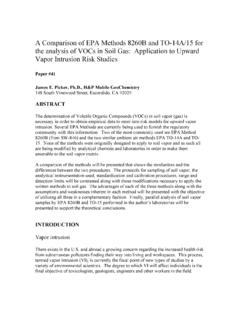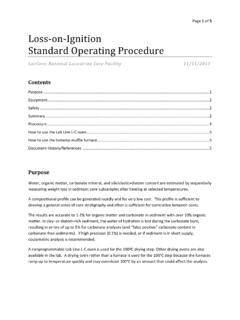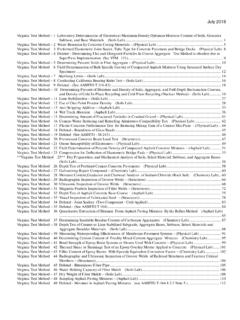Transcription of Investigation of the chrysotile fibres in an asbestos ...
1 Harpur Hill, Buxton Derbyshire, SK17 9JN T: +44 (0)1298 218000 F: +44 (0)1298 218590 W: of the chrysotile fibres in an asbestos cement sample HSL/2007/11 Project (s):G Burdett, Science Group:Science Group 5 Crown copyright (2006) ii 62 DESCRIPTION OF asbestos CEMENT .. Component materials .. 7 Typical appearance of asbestos 8 Effect of weathering on the surface 9 Effects of mechanical breakage .. 11 3 EXAMINATION OF AC: SAMPLE SOURCE AND PREPARATION .. 124 ANALYSIS .. TEM analysis .. 13 PLM analysis .. 13 5 RESULTS OF THE TEM ANALYSIS OF THE BULK SAMPLE .. Fibre morphology and structure .. 14 Energy dispersive X ray analysis results.
2 16 Selective area electron diffraction .. 23 6 RESULTS OF THE TEM ANALYSIS OF THE AIR SAMPLES .. 247 RESULTS OF THE PLM Evidence for changes to the chrysotile fibres .. 26 Evidence for coating of fibres .. 27 Evidence for airborne fibre 28 Evidence for loss of carcinogenic potency due to use of the asbestos in asbestos 28 Current EU and UK regulatory position on asbestos .. 29 3110 REFERENCES .. 3311 ANNEX 1: MEASURED AIRBORNE FIBRE CONCENTRATIONS FROM WORK WITH asbestos 36 iiiEXECUTIVE SUMMARY ObjectivesTo investigate whether claims of a physical and chemical change to chrysotile fibres in a cement matrix (A/C), are valid and merit further Investigation . Main Findings As would be expected in a sample of asbestos cement most of the chrysotile fibres were encapsulated in the cement matrix, often as quite large fibre bundles which are clearly visible to the eye.
3 When the cement is broken or crushed the chrysotile fibres are released from the cement. The fibres released were examined by analytical transmission electron microscopy (TEM) to determine whether they had been altered and were no longer identifiable as chrysotile asbestos . The fibres found in both the bulk and air samples had the characteristic morphology and appearance of chrysotile asbestos . The very fine fibres (fibrils), when viewed at higher magnification, showed the characteristic tubular structure associated with chrysotile fibrils and showed no evidence of surface alteration. Individual fibres analysed by energy dispersive X-ray (EDX) analysis showed chemistry similar to a reference standard of chrysotile and for published compositions for chrysotile from various mines around the world (when adjusted for water content).Different sections of the same fibres , also gave the characteristic selective area electron diffraction patterns associated with the chrysotile structure.
4 Three electron diffraction patterns were indexed and gave a close match to the published d-spacings for chrysotile . This demonstrated conclusively that there was no structural alteration of the atomic lattice of the chrysotile analysis carried out showed that the asbestos cement contained fibres of chrysotile asbestos and released chrysotile asbestos fibres to air when sufficiently disturbed. Many small particles of the cement matrix were present in the bulk preparations; some of these small particles would be close to or attached to the chrysotile fibres . These particles were calcium rich and added calcium to the spectra depending on how close they were to the electron beam / probe. ivOnly a small percentage of the fibres released from the cement could be described as being coated or altered and it may be more accurate to consider them as still encapsulated in the cement matrix.
5 There is no evidence from this examination to support claims that all the chrysotile asbestos in asbestos cement is significantly altered so that fibres present or released should no longer be considered to be chrysotile . Claims being made in Internet articles and in some sections of the newspaper industry are not supported by this Investigation . Epidemiology has shown that chrysotile is a human carcinogen. Animal experiments have shown no evidence that the chrysotile asbestos extracted from the weathered surface of A/C products is less carcinogenic than UICC standard chrysotile asbestos . RecommendationsThe lack of evidence for any significant changes to chrysotile fibres recovered from the cement matrix and released to air in the samples analysed for this report, argues against the need for any further consideration of the regulatory position of asbestos cement.
6 If there is any scientific data which could lead someone to believe that a new mineral has been formed, the appropriate procedure is to present the data for a review to the International Mineralogical Association. It must be borne in mind that asbestos cement may also contain crocidolite and amosite asbestos as well as chrysotile and these types of asbestos are also category 1 carcinogens and are considered by HSE to pose a greater risk to health than chrysotile asbestos . No claims have been made that these other types of asbestos are altered. Well-controlled secondary work with asbestos cement generally results in low airborne exposures to workers but some further sampling of typical work on friable weathered surfaces of asbestos cement should be considered, to see if exposures are increasing due to increased time of weathering.
7 6 1 INTRODUCTION Claims have been made in correspondence to HSE and in various media outlets (Bridle and Stone, 2006), that the chrysotile asbestos in asbestos cement products is altered, by an unexplained process, into a non- asbestos fibrous material. The claims being made suggest that this process is 100% efficient and no chrysotile asbestos remains in the matrix and also no actionable release of airborne asbestos fibres can occur. The outcome of these claims would be to show that, if white asbestos cement products are seen as no longer containing the chemical which has been banned, this should eventually exempt such products from many regulations . There is also the underlying assumption that the, fibres have been rendered safe by the attendant chemical process.
8 These observation are reported to be based partly on changes to the appearance of some of the fibres recovered from the matrix of the cement when viewed at high magnifications in a transmission electron microscope (TEM) and changes to the fibre chemistry as detected using energy dispersive x-ray analysis (EDXA) attached to the TEM (unpublished report by Pooley, , 2004). More specifically the claim made was; The conclusions which emerged from Professor Pooley s report were unequivocal. They confirmed that mixing with cement induces chemical and structural change to the chrysotile fibres . Increased levels of calcium and silicon and an increased tendency to aggregate leaves the fibre definitively altered. The aim of the work in this report was to investigate whether the claims that have been made are readily and uniformly observed and merit further Investigation .
9 Alternatively, if they occur only partially or are artefacts of the sampling and analytical procedures used, can they be discounted as a significant effect. The examination was carried out using similar methods to those that were been used to claim that changes to the chrysotile asbestos had occurred. Some additional electron diffraction analysis has also been carried issue appears to be similar to previous claims ( Deruyterre et al., 1980) that asbestos cement converted the chrysotile to a less hazardous material, which behaves more like a cement dust than an asbestos dust because small individual particles of cement were attached to the surface of the fibres . 7 2 DESCRIPTION OF asbestos CEMENT Component materials asbestos cement is usually a mixture of about 10% asbestos and 90% Portland cement.
10 The types of asbestos used may vary, chrysotile is normally always present but crocidolite and amosite ( asbestos grunerite) were also added to many products. Some sources of chrysotile asbestos also contain small amounts of tremolite asbestos but this is unlikely to be detected during routine examination. The product s performance requires that the cement matrix adheres to the outside of the fibres and fibre bundles so that the high tensile strength of the fibres is used to create a stronger product, than if just cement alone was used. The asbestos is added to the cement and wet mixed before being formed, compressed and cured to produce the end product. The addition of crocidolite and amosite was also used to help dewater the product quicker ( increase production rate) and / or to allow greater compression to produce a product of greater strength ( pressure pipes).
















